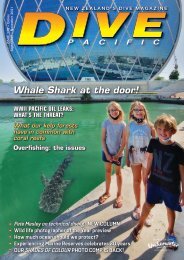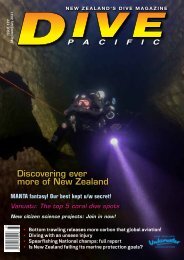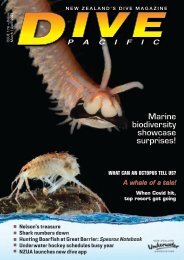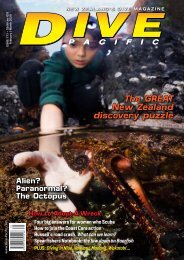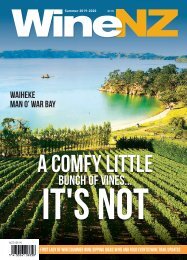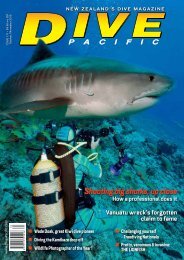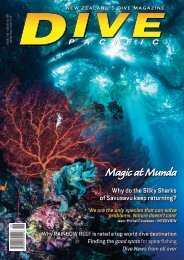Dive Pacific 175 Dec2020 Jan 2021
Dive Pacific, New Zealand's Dive Magazine , captures the best of diving in New Zealand and the Pacific. with adventures, top photos and expert technical advice
Dive Pacific, New Zealand's Dive Magazine , captures the best of diving in New Zealand and the Pacific. with adventures, top photos and expert technical advice
Create successful ePaper yourself
Turn your PDF publications into a flip-book with our unique Google optimized e-Paper software.
My best dive experience<br />
We had waited all week for<br />
Leeza, the owner manager<br />
of Triton Bay <strong>Dive</strong>rs Resort, to<br />
tell us we were going to see the<br />
incredible whale sharks.<br />
Whale sharks are a filter-feeder<br />
carpet shark, and the largest of<br />
fish species. Some grow to 18m<br />
making them by far the largest<br />
non-mammalian vertebrate, and<br />
the whale sharks around Papua<br />
are the only known<br />
non-migratory whale<br />
sharks in the world.<br />
Leeza announced<br />
that tomorrow was<br />
the big day. Someone would<br />
wake us at 5am and we had to<br />
be at the boat with all our gear<br />
by 6. Nobody needed to wake<br />
us - we were up and rearing to<br />
go, nervously hoping that after<br />
travelling all the way from New<br />
Zealand to Triton Bay in West<br />
Papua, we would get to see what<br />
we came for.<br />
Other guests had travelled<br />
greater distances: a couple from<br />
England; another from France;<br />
one from Italy. and one from<br />
Malta. We were three: husband,<br />
adult daughter and myself from<br />
Akaroa.<br />
Expectations were high. We<br />
excitedly made our way quickly<br />
to get the best position on one of<br />
the boats. I get sea sick so needed<br />
to be out in the fresh air, but the<br />
sea was flat calm as we made<br />
…the whale sharks around Papua are the only known<br />
non-migratory whale sharks in the world…<br />
the hour long trip to where the<br />
bagans, and hopefully, the whale<br />
sharks were. Bagans are lift-net<br />
vessels and whale sharks are<br />
attracted to them as fishermen<br />
hand out baitfish. The bagans<br />
move around a lot in the area but<br />
the resort boats knew exactly<br />
where to look.<br />
When we came up we went<br />
from bagan to bagan to see if the<br />
whale sharks were nearby. After<br />
the fourth my stomach dropped<br />
and I began feeling quite despondent.<br />
But a fifth one was pointed<br />
out and we headed there. And<br />
then the excitement mounted<br />
there were two whale sharks<br />
there. We had nine people on<br />
two boats with seven of them<br />
divers. My daughter, a snorkeler,<br />
had said she would be too scared<br />
to get in the water with them<br />
but she was the first to jump<br />
in, elbowing<br />
everyone out of<br />
the way.<br />
The two whale<br />
sharks were<br />
young males, the larger one over<br />
six metres and the smaller about<br />
five metres. Inquisitive creatures<br />
they were. They came over to<br />
inspect the boats then gracefully<br />
circled as they sucked in as many<br />
bait fish as they could, like large<br />
puppies.<br />
Whale sharks passively filter<br />
everything in their path with<br />
what’s called “cross- flow filtration”<br />
– water travels nearly<br />
parallel to their filter pad, not<br />
40 <strong>Dive</strong> New Zealand | <strong>Dive</strong> <strong>Pacific</strong>



